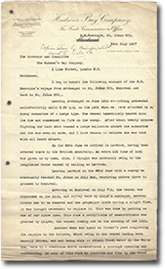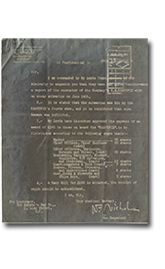Le 100e anniversaire de la Première Guerre mondiale est maintenant terminé, mais les documents continueront d’être conservés dans les Archives et accessibles aux générations actuelles et futures qui veulent en savoir plus sur cette époque. Ce blogue continuera aussi de faire partie de notre site Web en tant que ressource supplémentaire.
Juillet 2017 :
- Le 31 juillet : « Faire son devoir d’homme libre »
- Le 24 juillet : « On Active Service » : Herb Francis – suivi no 2
- Le 17 juillet : Exploration de Londres pendant une permission
- Le 10 juillet : Sous le feu de l'ennemi : le Nascopie rencontre un sous-marin allemand
- Le 4 juillet : Célébration du 50e anniversaire du Canada en France il y a 100 ans
Le 31 juillet 2017
« Faire son devoir d’homme libre »

agrandir
Après beaucoup de controverse et de débats, la conscription a été adoptée au Canada en août 1917. Avant cela, certains gouvernements, particuliers et groupes encourageaient activement les hommes à s’enrôler volontairement. La Citizens' Recruiting League, dirigée par plusieurs imminents Winnipegois, dont le juge en chef Thomas Mathers, était l’une de ces organisations.
Fred Livesay, domicilié au 166, rue Lipton, a reçu une lettre de la Citizens' Recruiting League en mars 1916. La lettre indiquait que M. Livesay avait été identifié comme un homme admissible au service militaire et lui demandait pourquoi il ne s’était pas encore enrôlé. La lettre concluait par ces mots :
« The Committee have no wish to hurt your feelings in any way in this connection. We feel sure that you are with us in the desire to see the cause of freedom and liberty win in the great struggle now going on, and are now communicating with you with the desire of giving you an opportunity of assuming the highest responsibility of British citizenship and doing your duty as a free man. »
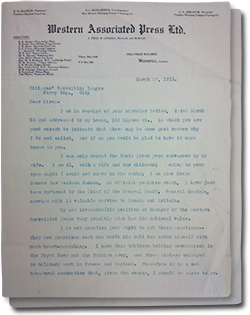
agrandir (2 images)
M. Livesay, marié et père de deux enfants, a répondu qu’il n’était pas admissible à servir dans les rangs en raison de troubles de la vue et qu’on ne lui avait pas offert de poste d’officier. De plus, il a suggéré qu’il servait son pays par son travail de censeur de la presse pour l’Ouest canadien et de gestionnaire de la Western Associated Press.
Cependant, M. Livesay a écrit :
« I do not question your right to ask these questions –– they are question each man worth his salt has asked himself with much heart-searching. I have four br[o]thers holding commission in the Royal Navy and the British Army, and three sisters employed in military work in France and England. Therefore, it is a not unnatural assumption that, given the chance, I should be eager to go. »
Par la suite, M. Livesay a servi comme correspondant de guerre auprès du corps canadien sur le front ouest en 1918 jusqu’à la fin de la Première Guerre mondiale et a parlé de ses expériences dans son livre « Canada’s Hundrer Days : with the Canadian Corps from Amiens to Mons, August 8 – November 11, 1918. »
Conseil de recherche : Cherchez « J. F. B. Livesay » dans la banque de données Keystone pour de plus amples renseignements.
Commentaires (0)
Envoyez vos courriels à l'adresse suivante : [email protected]. Que pensez-vous de cette blogue article? Vous êtes aussi invités à afficher vos commentaires sur cette page.
24 juillet 2017
« On Active Service » : Herb Francis – suivi no 2
Comme nous l'avons mentionné dans notre billet de blogue du 1er mai 2017, lorsque nous avons créé l'exposition « On Active Service » en 2015, nous avons cherché dans nos fonds et collections des photographies de chaque soldat dont nous exposions les lettres. Nous n'avions pas pu trouver de photographies de deux d'entre eux : Frank Leathers et Herbert Francis.
Au cours des derniers mois, nous avons réussi à trouver des photographies des deux hommes dans nos fonds et collections et nous avons été vraiment enthousiastes de voir à quoi ressemblaient ces deux correspondants. Le billet précédent portait sur Frank Leathers et celui-ci porte sur Herb Francis.
Nous avons récemment acquis les dossiers de Colin Black, un autre manitobain qui a servi pendant la Première Guerre mondiale. L'archiviste qui travaille sur ces dossiers a découvert une photographie de Colin Black dans l'album photo de The Lord Selkirk Association of Rupert's Land. Colin Black était le petit-fils du révérend John Black, un des premiers colons de la Rivière-Rouge.
Un autre archiviste s'est souvenu que Herb Francis était également le petit-fils du révérend Black et lorsqu'on a découvert que la photographie montrait certains des petits-fils du révérend Black qui avaient servi pendant la Première Guerre mondiale, nous avons constaté que cette photographie montrait Herb Francis et son frère Charles dont les dossiers se trouvent également dans les fonds et collections des Archives.

agrandir

agrandir dans sa taille
Photo 1. Grandsons of Rev. John Black - on active service 1914-1918:
Ross Black, Hugh A. Black, Herbert Francis, Charles Francis, John Black, Thomas W. Laidlaw, Colin F. Black, [ca. 1916], P7912.
Nous avons exposé l'album de The Lord Selkirk Association à notre récente activité portes ouvertes pour célébrer le 100e anniversaire de la bataille de la crête de Vimy, ainsi que certaines des lettres et d'autres dossiers de Herb et Charles. Ce fut merveilleux pour les visiteurs de pouvoir voir les hommes qui ont écrit les lettres et d'établir plus de liens entre les gens et les dossiers dans nos fonds et collections.
Conseil de recherche : Cherchez « Lord Selkirk Association » dans la banque de données Keystone pour en apprendre davantage sur l'album photo et « Sarah Margaret Francis » pour en apprendre davantage sur Herb et Charles Francis et leurs correspondances pendant la Première Guerre mondiale.
Commentaires (0)
Envoyez vos courriels à l'adresse suivante : [email protected]. Que pensez-vous de cette blogue article? Vous êtes aussi invités à afficher vos commentaires sur cette page.
Le 17 juillet 2017
Exploration de Londres pendant une permission
Colin Francis Black est né à Carman, au Manitoba, en 1896. Il était étudiant à l'Université du Manitoba et membre du Corps-école d’officiers canadiens (CEOC) lorsqu'il s'est enrôlé comme soldat dans le 196e bataillon en 1916. M. Black s'est embarqué pour l'Angleterre en novembre 1916 sur le S. S. Southland et a été stationné au Seaford Camp.
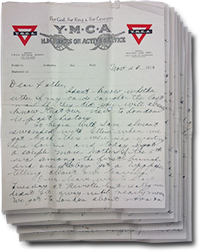
agrandir (8 images)
Colin Black correspondence 1916, P7733/1.
Le 28 novembre 1916, Colin Black a écrit à son père pour lui raconter ses aventures pendant une permission à Londres.
« We got in a taxi and went to the Maple Leaf Club which is run exclusively for Canadian Soldiers by London Society. They charge 1s 4d for bed and breakfast and a real place at that. Princess Pat waiting on one of the tables one day but we didn’t know it until after we were done. »
M. Black et ses amis sont allés au théâtre et au restaurant où il a noté des différences entre Londres et le Manitoba :
« Things here aren’t any more expensive than any ordinary hotel but they put up in grand style. One thing strange here all the ladies smoke in the theatres and restaurants. »
Ils ont également visité des attractions de Londres, dont le Musée de Madame Tussaud :
« We went to the wax works too. These are world famous for their naturalness. We saw all the worlds past & present celebrities including Miss Cavell. One thing funny happened there. One of the boys stood up in a corner resting on his cane and attracted the admiration of a few girls that were passing when they got close he gave a yell and they nearly died with fright. »
Colin Black a servi en France avec le bataillon canadien de fusiliers à cheval de mars à août 1917. Il a été hospitalisé en août 1917 après avoir contracté la diphtérie en France et a ensuite été transféré dans un hôpital en Angleterre. M. Black n'a pas complètement guéri et a été réformé en mars 1918.
Consultez notre billet de blogue du 24 juillet 2017 pour en apprendre davantage sur la famille Black et pour voir une photographie de Colin Black et d'autres membres de sa famille qui ont servi pendant la Première Guerre mondiale.
Conseil de recherche : Cherchez « Colin Blanc » dans la banque de données Keystone pour avoir de plus amples renseignements.
Commentaires (0)
Envoyez vos courriels à l'adresse suivante : [email protected]. Que pensez-vous de cette blogue article? Vous êtes aussi invités à afficher vos commentaires sur cette page.
Le 10 juillet 2017
Sous le feu de l'ennemi : le Nascopie rencontre un sous-marin allemand
La Compagnie de la Baie d’Hudson n’est pas connue pour ses exploits de guerre héroïques pendant la Première Guerre mondiale. Pourtant une histoire au sujet du brise-glace Nascopie a mis la compagnie au cœur de l’action. On y parle d’un échange de coups de feu avec un sous-marin allemand.
Le capitaine Edmund Mack a signalé l’incident au gouverneur et au comité à Londres le 30 juillet 1917 :
« Leaving Archangel on June 12th everything proceeded satisfactorily until 2.30 pm, on the 14th when we were attacked by an enemy submarine of a large type. The vessel immediately headed into the ice and commenced to fire on the enemy. After about twenty minutes fighting our last shot caused a large explosion aboard the submarine and she was seen no more, and I have reason to believe she was sunk with all hands aboard. »
Transcription de la lettre de capitaine Edmund Mack au gouverneur et au comité.
All correspondence to be addressed The Fur Trade Commissioner, Hudson’s Bay Company, Montreal
Cable address “Beaver” Montreal
Hudson’s Bay Company, Fur Trade Commissioner’s Office
S.S. Nascopie, St, Johns Nfd,
30th July 1917
In your reply refer to No ____.
The Governor and Committee, The Hudson’s Bay Company, 1 Lime Street, London, E.C.
Gentlemen,
I beg to submit the following account of the S.S. Nascopie’s voyage from Archangel to St, Johns Nfld, Montreal and back to St, Johns Nfd,.
Leaving Archangel on June 12th everything proceeded satisfactorily until 2.30 pm, on the 14th when we were attacked by an enemy submarine of a large type. The vessel immediately headed into the ice and commenced to fire on the enemy. After about twenty minutes fighting our last shot caused a large explosion aboard the submarine and she was seen no more, and I have reason to believe she was sunk with all hands aboard.
On the 29th June we arrived in Lerwick, having been ordered there by the British Admiralty. An extra 100 tons of coal was given us by them, this I thought was necessary owing to the lengthened route caused by calling at Lerwick.
Leaving Lerwick on the 23rd June with a convoy we eventually reached St. Johns on July 2nd, receiving orders there to proceed to Montreal.
Arriving at Montreal on July 7th, the vessel was drydocked on the 11th, and survey held by Lloyd's surveyor, several rivets had to be renewed and one propellor blade having a slight flaw, it was thought necessary to replace it. This was done by putting on one of our spare ones. This done a certificate of seaworthiness was granted by Lloyds, the vessel coming out on the morning of the 13th.
Another week was spent at Vicker’s yard completing the repairs to the boilers, which owing to the vessel having been heavily driven, and not being able to obtain fresh water in the White Sea, were in a condition which necessitated a thorough cleaning and overhauling. As much as possible was done by the Chief
-2-
Engineer and his engine room staff.
The vessel commenced to bunker on the 20th July, and left Montreal on the 26th, for St. Johns Nfd, to pick up more cargo and passengers.
Mr, Mully arrived safely in Montreal, and was great assistance in assembling the cargo. Mr Walters is I believe leaving for home on the Grampian. He proved himself to be an efficient officer, although lacking the knowledge required for the trade in which this vessel is engaged.
I am pleased to state that during the action with the submarine the gunners, and the gun’s crew showed great coolness in handling their gun, and in the accuracy of their fire, and consider it was due to them the attack on us was not successful. The vessel was in no way damaged, although several shells fell close, and went over us.
I have completely recovered from my illness contracted at Archangel, and now feel perfectly fit, although I am taking the necessary precautions ordered by the Doctor against the cold weather, as he stated another such attack would be serious.
I have had to make one or two changes in the crew especially amongst the firemen, and have sent home two boys signed in Cardiff as they were absolutely useless and only filled up accommodation needed. The Shipping Federation gave me every assistance in this matter. I am pleased to say all the old hands turned out well during the trying work of the winter.
Trusting to make a successful voyage around Hudson’s Bay,
I am, Gentlemen, Your obedient Servant [signed G. Edmund Mack] Master
Transcription de la lettre de gouverneur et au comité au capitaine Edmund Mack.
L.P. – No. 8.
In any further communication on the subject, please quote M. 68845/17 and address letter to – The Secretary, Admiralty, Whitehall, London, S. W.
-: Confidential :-
27th August 1917
Sir,
I am commanded by My Lords Commissioners of the Admiralty to acquaint you that they have had under consideration a report of the encounter of the Company’s S.S.Nascopie with an enemy submarine on June 14th.
2.- It is stated that the submarine was hit by the Nascopie’s fourth shot, and it is considered that some damage was inflicted.
3. – My Lords have therefore approved the payment of an award of £150 to those on board the “Nascopie,” to be distributed according to the following share basis:
- Master: 80 shares
- Chief Officer, Chief Engineer: 30 shares (each)
- Other officers, Engineers, Surgeon and Purser: 20 shares (each)
- Boatswain, Carpenter, Steward, Gunlayers, W/T operators, and Donkeyman: 12 shares (each)
- Quartermasters & Cook: 8 shares (each)
- Seamen, Firemen, Greasers and Apprentices: 5 shares (each)
- Asst. Cooks & Stewards and Ships Boys: 3 shares (each)
4.- A Navy Bill for £150 is attached, the receipt of which should be acknowledged.
I am, Sir, Your obedient Servant, [signed W.F. Nicholson] for Secretary.
The Secretary, The Hudson’s Bay Co., 1, Lime Street, E.C.
Hudson's Bay Company Archives, Archives of Manitoba,
Governor and Committee general inward correspondence, 1911-1923,
HBCA A.10/189a.
Dans sa lettre, il loue son équipage pour sa ténacité sous pression. L’amirauté britannique a par la suite écrit au gouverneur et au comité pour les informer qu’elle avait remis à l’équipage du Nascopie la somme de 150 £ à se partager.
Bien qu’il ait été déterminé plus tard que le sous-marin n’avait pas été coulé, l’incident demeure une histoire précise de la participation de HBC à la Première Guerre mondiale.
Pour d’autres histoires sur le Nascopie, veuillez consulter nos billets de blogue des 12 janvier 2015, 9 février 2015, 2 mars 2015 et 15 juin 2015.
Conseil de recherche : Cherchez « Nascopie » dans la base de données Keystone pour de plus amples renseignements sur ce brise-glace.
Commentaires (0)
Envoyez vos courriels à l'adresse suivante : [email protected]. Que pensez-vous de cette blogue article? Vous êtes aussi invités à afficher vos commentaires sur cette page.
Le 4 juillet 2017
Célébration du 50e anniversaire du Canada en France il y a 100 ans
Les Archives du Manitoba ont récemment acquis le journal de Wilfred Conway Rutherford, un soldat de la Première Guerre mondiale de La Rivière, au Manitoba. Il s’est enrôlé en mars 1916 auprès du 184e bataillon outre-mer et a été envoyé en France en février de l’année suivante.
M. Rutherford a écrit des entrées régulières et détaillées décrivant ses activités, ses pensées et ses sentiments quotidiens.
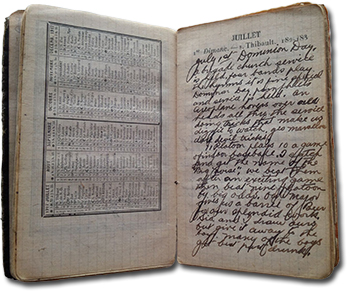
agrandir
Archives of Manitoba,
Wilfred Rutherford diary, 1917
P7913/6
En juin 917, M. Rutherford et son unité étaient derrière les lignes pour se reposer et, dans l’entrée de son journal du samedi 30 juin 1917, il a écrit :
« When I think of tomorrow being the 1st of July I feel lonely and Sunday [too] adds to my lonely [thoughts]. A year ago I was much nearer home. »
Le lendemain, il souligne les activités des soldats en l’honneur de la fête du Dominion, maintenant connu sous le nom de fête du Canada.
« July 1st Dominion Day. A brigade church service is held. Four bands play the hymns it is fine. Special Dominion Day pamphlets and service is held. An aeroplane hovers over our heads all through the service doing tricks that make us dazzle to watch. Yes marvellous dare devil tricks.
« 11 Platoon plays 10 [Platoon] a game of indoor baseball. I catch and get the name of the "Big Noise" we beat them after an exciting game then beat nine platoon by big odds. Our major gives us a barrel of Beer for our splendid work. Sia and I draw ours but give it away to the boys. Many of the boys get best part drunk. »
Le jour suivant, l’unité de M. Rutherford a levé le camp et est retournée au front. M. Rutherford a été blessé au pied le 23 juillet.
Son journal sera bientôt décrit dans la base de données Keystone et pourra être consulté dans la salle de lecture des Archives.
Commentaires (0)
Envoyez vos courriels à l'adresse suivante : [email protected]. Que pensez-vous de cette blogue article? Vous êtes aussi invités à afficher vos commentaires sur cette page.



